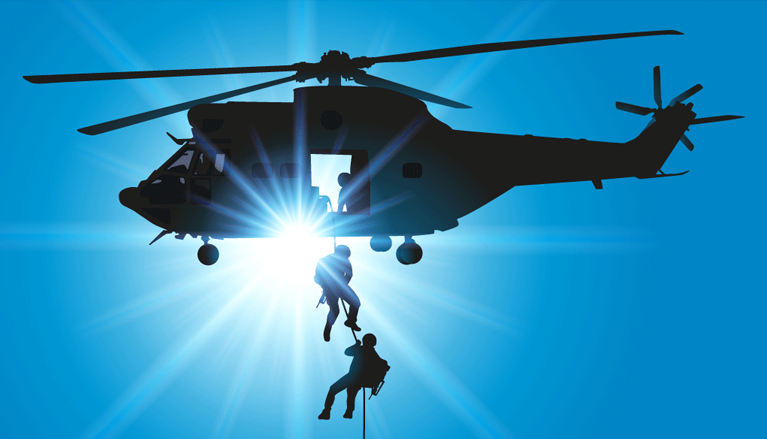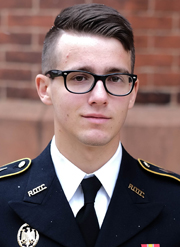SRU cadet graduates from rigorous U.S. Army Air Assault School

Nov. 13, 2017
SLIPPERY ROCK, Pa. - Despite having to deal with the normal challenges of a new, academic year, Slippery Rock University Army ROTC Cadet Donald Sanders added to his workload significantly by attending the U.S. Army's Air Assault School, an intensive 10-day course designed to prepare soldiers for insertion, evacuation and pathfinder missions that call for the use of multipurpose transportation and assault helicopters.
Sanders, a senior criminology and criminal justice major from Aliquippa, was selected as one of approximately 200 ROTC cadets from across the country to attend Sabalauski Air Assault School in Fort Campbell, Kentucky alongside enlisted soldiers.
"It's not an opportunity that a lot of people get to have in ROTC," Sanders said. "For example, if there are 100 cadets between Slippery Rock and Clarion universities, maybe three or four of us are qualified to go for this sort of thing."

SANDERS
From Aug. 22 to Sept. 11, the AAS hosted 30 classes that ran cadets through combat assault, sling loading and rappelling exercises. Each of these phases lasted three full days and involved intense concentration along with a commitment to safety and preparation.
"The first day is called Day Zero, and until you pass Day Zero, you aren't even considered an Air Assault student yet," said Sanders. "There is a two-mile run and a series of obstacle courses that you have to face along with the logistics of getting your paperwork processed properly."
Once having accomplished the rigors of Day Zero, soldiers and cadets were then ushered into the combat assault phase as official Air Assault students. Students spent this phase learning about aero-medical evacuation, pathfinder operations and combat operations, along with the different airframes that the Army utilizes.
At the close of the combat assault phase, students underwent two tests, both of which they were required to pass in order to graduate to the sling loads phase.
"First, we had a written test, which proves all that you have learned in classes up to that point," Sanders said. "Then we underwent a hands-on exam which tested our hand and arm signals. These signals are what you use to guide a helicopter, direct it to hover or order it to land or take off. You needed to demonstrate a clear understanding of these in order to move forward in the class."
During the sling loads phase, students learned how to rig equipment onto rotary aircraft using a sling. Generally, this operation requires a soldier to hook a tether to the underbelly of a helicopter while it hovers just a few feet above the round. A typical load can range anywhere between 1,000-8,000 pounds.
"This phase is definitely the hardest and the most important of the entire course," said Sanders. "Not only do you have to learn how to hook up loads, they also teach you how to inspect them and identify any deficiencies. A lot of people fail during sling loads, but once you pass, it feels like a huge sigh of relief."
Following a written and hands-on exam, trainees then proceeded to the third and final phase, rappelling. Soldiers and cadets received basic instruction on ground and aircraft rappelling procedures. By the end of the phase, trainees completed two descents from a 34-foot tall tower in addition to two rappels from a UH-60 Blackhawk helicopter, hovering between 70 and 90 feet above the ground.
"Not every class has that opportunity based on weather and access to the aircraft. We were really fortunate in that regard," said Sanders. "It really was an amazing experience and I'm so glad I got to do that as a cadet."
On graduation day, students had to complete a 12-mile ruck march in less than three hours. Dressed in his Army combat uniform along with full body armor, 35 pounds of gear and a weapon, Sanders completed the march in two and a half hours, placing seventh in the class.
"The ROTC cadets performed really well during this march, and I was so proud to be part of them," said Sanders. "Of the 10 of us in that class, five of us placed in the top 10, and we all graduated. In a school where about 50 percent of students fail, we were very fortunate to all pass."
Sanders, who will commission as an active duty 2nd Lt. following graduation, hopes to use his time at the school as a leg-up for his career.
"If I deploy, attending Air Assault School will definitely be an asset to my future," he said. "Whether you need to resupply your troops by helicopter or you're conducting an actual air assault, the training you receive at Fort Campbell is invaluable."
MEDIA CONTACT: Maizee Zaccone | 724.738.2091 | mxz1016@sru.edu

